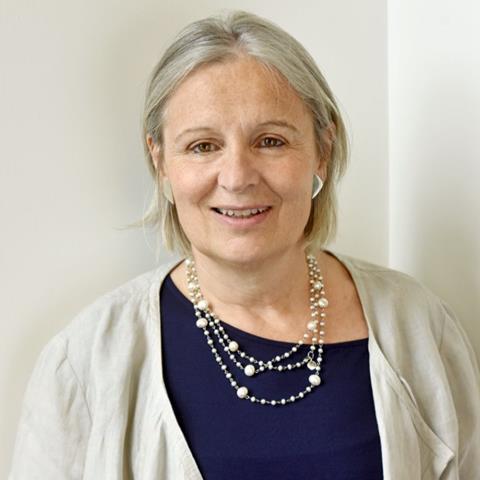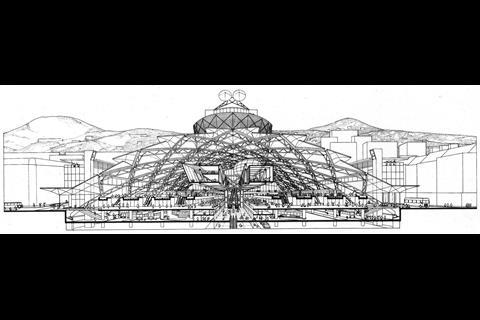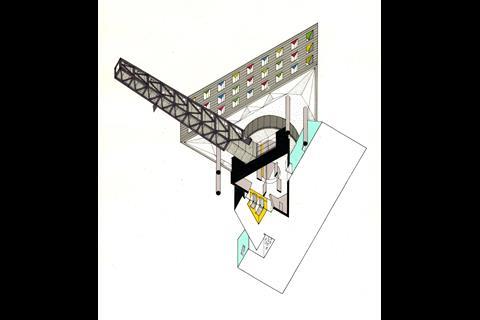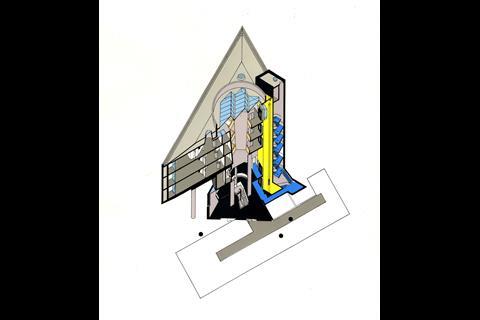Leading architects pay tribute to architect who was ’a solid mentor and friend you could always rely upon’.
Chris Dyson, Barbara Weiss and Patrick Lynch have led tributes to Michael Wilford, whose death was announced yesterday.

Dyson, who was an associate at James Stirling, Michael Wilford and Associates, said: “I started working with Jim and Michael aged 25, having graduated from the Mack in Glasgow. It was like an extension of university education; each project involved research into historical background of the place and a fresh interpretation of the architectural language.
“There was no obvious solution, no house style – we would refer to other projects in passing, and often the work of great, usually dead, architects. The plan was the originator – initially quite diagrammatic, it was then fleshed out using the axonometric, the worm’s eye, the split up view and the single-point perspective.
“Projects discussed include No 1 Poultry, Staatsgalerie Stuttgart and Abando Passenger Interchange, Bilbao (above). The initial conversation with Jim about this project I remember well – ‘How do we avoid the box?’ He sketched out a box, implying that stations had by that time become dull shopping centres with little contextual connection.
“The challenge was to create inviting, interesting and three-dimensional civic space from an interchange, and I think we achieved that in this unbuilt design.”

Barbara Weiss said: “I am very saddened by the news of Michael’s early death… he was someone one felt would be around forever, a solid mentor and friend you could always rely upon.
“I first met Michael in 1976, when I worked at Stirling Wilford and Associates as a student on the Tuscan Regional Headquarters competition. In subsequent years I had the pleasure of working with him on several different projects, and also of travelling with him to Italy, with or without Jim Stirling.
“In the somewhat chaotic and creative world of Stirling Wilford he was always the voice of reason, the one you could go to for any sort of practical or professional advice. I learned a lot from him, and thoroughly appreciated his sensible and matter-of-fact approach to any sort of challenge, whether architectural, technical or logistical.
“As I got to know him better over the years, I discovered a man deeply committed to his extraordinary family and to community values, endowed with a wry sense of humour, one that stood him in good stead in a wonderful practice that lunged between highs and lows, and where he was definitely Mr Fix-it.”

Patrick Lynch said: “We met many times at the University of Liverpool, where Michael was always gracious and kind. He enjoyed discussion and the thrill of architectural culture. As he had initially trained as an architectural technician, Michael had perhaps a very Romantic view of architectural education, and relished its freedom.
“The Staatsgallerie is one of my favourite buildings, and we very much enjoyed visiting the school of architecture at Rice University when we visited Houston, which Wilford was the author of I beleive. It sits very demurely next to the Divinity School and the main quad, like a modest Franciscan chapel.
“The inside is also incredibly intellectually satisfying, well ordered, and in parts, thrilling. The crit space sits at the heart of the plan and opens onto a courtyard where the students make physical models.
“This combination, of a place to talk about architecture right beside a space to make it, sticks in my memory as pretty much an ideal model for an architecture school. He was a thoroughly decent architect, in every sense of the word.”
Claudia Lynch, of Lynch Architects, added: ”Michael Wilford gave me my first job after I graduated from university in 1997. The walls of the office in Fitzroy Square were covered in framed original drawings of Stirling/Wilford projects, in ink and colour pencil.
”This culture of drawing, by that time with the help of the computer, was at the core of everything. Michael guided us into drawing very precisely, and also editing to suit different purposes, as a means of translating ideas, and information, into a universal language. He was demanding and generous, and I am grateful to him for introducing me to professional life as an architect.”
Robert Dye said: “I owed my eight year stint at Stirling Wilford to Michael as he interviewed me after finishing Part 2 and generously ‘overlooked’ my thesis project which was openly critical of their Turner Gallery at the Tate, although I did wonder whether it was him or Jim who put me to work on toilet details.
“Michael & Jim had one of those great complementary partnerships without outward signs of friction and a clear understanding of what had to be done and when.
“Michael had huge energy and commitment. His mental power amazed me many times particularly when I was building Cornell Performing Arts Centre; with his photographic memory, he’d recall key correspondence from years before which supported his ability as an outstanding negotiator.
”He took a more active role in management of the practice than Jim in my time but this clearly worked for both partners. Stirling & Gowan’s partnership was before my time so I can only try to imagine Michael as a young assistant sitting at a desk between those two titans.
“Full credit Michael for not only surviving but then going on with Jim to build a brilliant practice and so many great buildings.”
RIBA President Simon Allford said: “Michael Wilford was gifted architect and an important figure in the London architectural scene. His talent is highlighted by the fact that larger-than-life Jim Stirling chose to make him his partner and to rename the practice accordingly.
“Michael’s work for, and then with, James Stirling included the German museum series, the Berlin projects, including the British Embassy which on completion after Jim’s death won a RIBA European Award and was shortlisted for the 2001 Stirling Prize. It also includes the posthumously completed No 1 Poultry building - being the decisive conclusion of The Lord Palumbo’s long drawn-out Mansion House ambition, and crucially, the practice’s major London landmark and legacy.
“Wilford working alone will be remembered for iconic cultural hubs such as Liverpool’s Tate and Salford’s playful Lowry arts centre. His individual architectural legacy will live on through his development of an unmistakeable feel for colour and striking use of form.
“As a young architect, I got to know Michael, who took the time to engage with and support the next generation. Indeed, as a struggling fledgling practice we at AHMM had the pleasure of being invited to work in the background supporting some of their international work. We benefitted greatly from the learning experience and the generous fees!
“My thoughts are with his wife Angela, his five children, and the many who knew and admired him.”



















1 Readers' comment